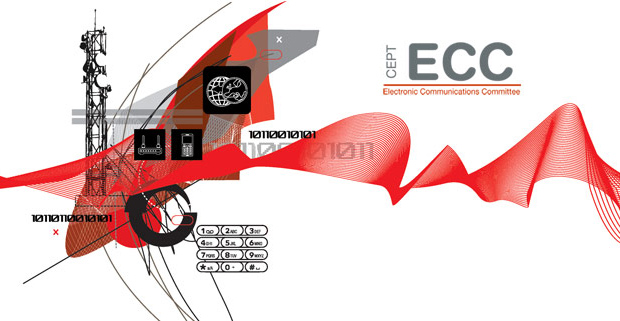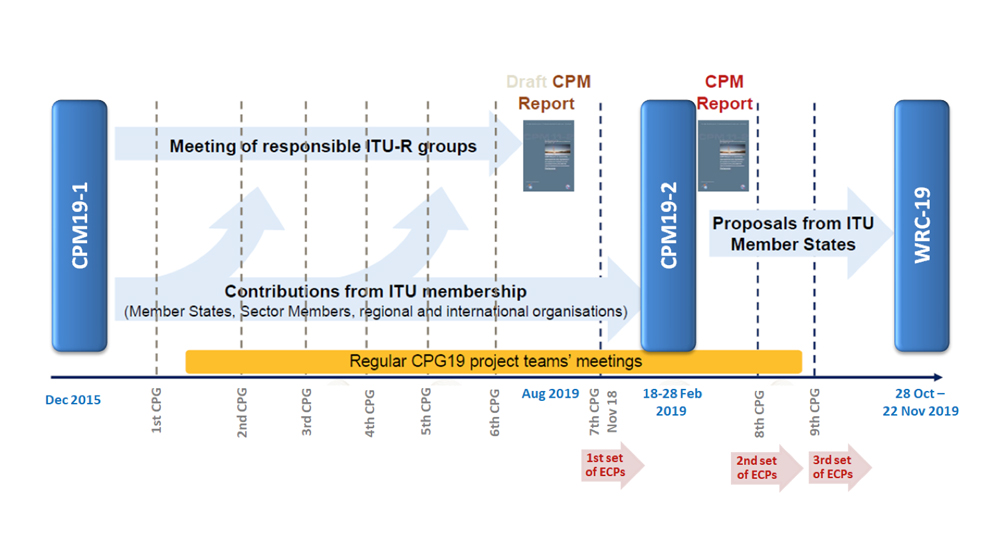ECC Newsletter December 2018
Europe prepares to shape the radiocommunications of the future at WRC-19
The World Radiocommunications Conference is now less than a year away. Several thousand delegates from all over the world are expected to meet at the event, which takes place in Sharm el-Sheikh (Egypt) from 28 October to 18 November, 2019. They will review and revise, as appropriate, the ITU Radio Regulations (RR).
CEPT, through the work of the ECC Conference Preparatory Group (CPG), is preparing its proposals for the Conference, and will provide its own view on shaping radiocommunications of the future. In the last three years, CPG has worked on the Agenda agreed for WRC-19 at the previous Conference, carrying out studies, participating actively to the preparation in ITU-R, and developing CEPT positions and views for the various Agenda items.
Although WRC-19 is almost one year away, CEPT has already unanimously adopted five European Common Proposals (ECPs). These proposals support no change to the RR for Agenda items on railway communications, intelligent transport systems and radio local area networks (RLAN) in the bands 5250-5350 MHz, 5350-5470 MHz and 5850-5925 MHz. They take utmost account of the results of the study activities, and, in the case of railway communications and intelligent transport systems, spectrum harmonisation opportunities outside the WRC process. Several ECPs are also expected to be approved next May, including proposals for initial bands suitable for 5G, as well as those that are currently deemed not suitable for 5G (i.e. 31.8-33.4 GHz, 71-76 GHz and 81-86 GHz). The last set of ECPs will be ready in August next year.
CEPT is further looking forward to the upcoming second session of ITU´s Conference Preparatory Meeting (CPM19-2) in February. This will be the first opportunity for CEPT to defend its own views when the methods to resolve the various Agenda items are consolidated. After CPM, CEPT will finalise its proposals for the Conference and will seek to achieve broad support for them.
Figure 1 - Development of the European Common Proposals
Figure 2 - Timeline of the work in CEPT until the next WRC-19
Broadband communications
The global harmonisation of suitable spectrum for 5G (IMT-2020) is certainly among the most debated Agenda items. Due to the fact that 5G envisages very high data rates, much larger bandwidths than ever before will be required ̶ up to several GHz ̶ which can only be found in higher frequency bands. WRC-15 agreed to consider a number of bands above 24 GHz for the use of 5G. Compatibility with existing users in the same and adjacent bands needs to be taken into account. CEPT has focussed its work on a set of priority bands based on the CEPT 5G roadmap: 24.25-27.5 GHz, 40.5-43.5 GHz, 66-71 GHz.
The first of these, 24.25-27.5 GHz, referred to as the 26-GHz-band, has been identified in Europe as a pioneer band for 5G. CEPT has already harmonised it under ECC Decision (18)06 and plans to promote the band for IMT at WRC-19, with the conditions outlined in this ECC Decision.
The 40.5-43.5 GHz band is also proposed for 5G. This band is considered in light of a possible tuning range concept, which involves the adjacent band 37.5-40.5 GHz allowing a global identification for IMT. Although, CEPT administrations have no intention to use this lower range for 5G.
The 66-71 GHz band is also proposed for IMT identification while noting that wireless access systems (e.g. WiGig) should have equal access in this band.
For the bands not deemed suitable for 5G, no change to the RR is proposed, while some remaining bands (45.5-50.2 GHz and 50.4-52.6 GHz) are still under discussion.
Besides its work on 5G, WRC-19 will consider other systems and applications to provide wireless broadband connectivity. For instance, studies are still ongoing in CEPT to assess if proper conditions and mitigation techniques would allow additional RLAN uses in the 5725-5850 MHz and 5150-5250 MHz bands. Connectivity solutions through high altitude platforms (HAPs) are also gaining momentum, with the recent advent of new technologies. In this respect, the bands at 6 GHz, 28 GHz, 31 GHz, 38 GHz, and 47 GHz for HAPs use are of interest in Europe, and studies will be finalised in the upcoming months.
Satellite communications
WRC-19 will discuss how to meet the demand for spectrum for different types of satellite uses. On one hand, the quick uptake of new systems such as non-geostationary satellite (non-GSO) systems requires a proper regulatory response. On the other hand, provisions need to ensure that undue legacy limitations are avoided and the deployment of already admitted uses is effectively viable.
In view of the increasing interest in non-GSO systems, CEPT is proposing appropriate measures to allow these systems in new bands at 40/50 GHz while ensuring they can also operate in the bands which, from a regulatory perspective, are already available to non GSO systems, such as the 3700-7025 MHz range. CEPT is also working on the proper definition of a milestone-based approach, which will bring into use frequency assignments to non-GSO systems. This will provide a degree of regulatory certainty while recognising that non-GSO constellations may generally take time to be fully deployed. Simplified procedures for non-GSO short duration satellite systems are also being discussed.
Furthermore, there is a strong interest in the usage of the 17.7-19.7 GHz and 27.5 29.5 GHz bands for satellite earth stations in motion (ESIM) operating with geostationary space stations. This matter is considered in continuity with the work of WRC-15, which opened the 19.7-20.2 GHz and 29.5-30.0 GHz bands to ESIM. With the ECC Decision (13)01, the harmonised use of ESIM in these bands has already been achieved in Europe. However, the discussion is still ongoing about the proper operational conditions, coordination methodologies and responsibilities for operation and interference management which CEPT will propose at WRC-19 for maritime, aeronautical and land ESIM.
Each WRC considers possible changes to the satellite regulatory procedures. In preparation of WRC-19, 13 different issues have been identified on a variety of satellite procedures. These include measures to facilitate newcomers who want to access satellite orbits, and procedures to convert and record administrations’ assignments in the ITU Master Register. Proposals have already been developed for some of these issues while others are still under discussion. This highlights that CEPT favours the review or development of any RR provision which can bring accurate solutions to specific inconsistencies, and focusses on the most urgent issues.
Aeronautical and Maritime communications
In the preparation of WRC-19, a significant effort is dedicated to the Global Maritime Distress and Safety System (GMDSS), which is needed to improve communications and enhance maritime capabilities. The recent recognition of the Iridium satellite system as part of the GMDSS requires regulatory actions. According to the CEPT view, this would include the allocation of primary spectrum to the maritime mobile-satellite service (MMSS) in the band 1621.35-1626.5 MHz while ensuring protection to radio astronomy and existing MMSS operations in the adjacent frequency band.
WRC-19 will also consider possible new spectrum allocations for MMSS to enable the satellite component of VHF data exchange systems (VDES-SAT). VDES-SAT offers potential enhancements to maritime safety and CEPT is in favour of the allocation of proper spectrum on a primary basis at 160.9625-161.4875 MHz. Provisions on channelisation and coordination mechanisms for these systems need to be defined, too.
After two serious aeroplane accidents, the last WRC-15 also agreed on the necessity to identify either additional spectrum or regulatory provisions to facilitate the Global Aeronautical Distress and Safety System (GADSS). CEPT is now discussing the most appropriate solution to recognise GADSS in the relevant parts of the RR dealing with distress and safety communications.
Scientific use of spectrum
Short duration non-GSO satellites, with a life span of typically less than three years, offer great potential for a variety of scientific and experimental missions. These satellites require telemetry, tracking and command (TT&C). This has led to the challenging task of assessing the suitability for TT&C of spectrum already allocated to the space operation service (SOS) below 1 GHz, alongside considerations on a possible upgrade of the existing allocations, or even a new allocation to SOS. When it comes to short duration non-GSO satellites in the space-to-Earth orbit, CEPT is still discussing alternative options. These have a common element in the identification of the existing allocation to the space-operation-service in the frequency band 137-138 MHz. There is a need to strike the right balance in the regulatory environment for such satellite missions.
A specific Agenda item for WRC-19 deals with the growing use for TT&C in the 401-403 MHz and 399.9-400.05 MHz bands under the Earth exploration-satellite service (EESS), meteorological satellite service (MetSat) or mobile satellite service. Power limits would reduce the impact of the TT&C usage on the existing, lower power data collection system stations. Such stations communicate to sensitive receivers and typically work at lower power levels. To provide confidence and long-term continuity to space and meteorological data collection system programmes of great public interest, CEPT is also considering the allocation of primary spectrum for MetSat and EESS (downlink) at 460-470 MHz. However, the conditions to ensure protection of services in the same and adjacent frequency bands still need to be defined.
Future agenda
Each Conference has a standing Agenda item which regards the definition of the provisional Agenda of future Conferences. In 2015 a provisional Agenda for WRC-23 was already defined, which includes for instance the continuation of the GMDSS modernisation and the review of the spectrum use in the 470-960 MHz band in Region 1. There´s a general support for this provisional Agenda, however, further consideration is required on the needs and possible new allocations to the fixed satellite service at 37.5-39.5 GHz. CEPT has also received a number of new proposals, which will be further discussed and developed in the next year.
Doriana Guiducci Spectrum Expert, European Communications Office
Peter Faris, Spectrum Expert, European Communications Office





